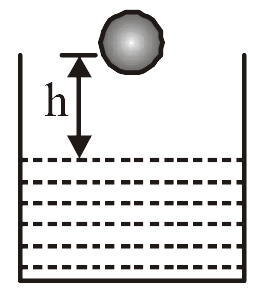A solid ball of density half that of water falls freely under gravity from a height of 19.6 m and then enters water. Neglecting air resistance and viscosity effect in water, the depth up to which the ball will go is (g=9.8m/s2)
19.6 m
9.8 m
14.7 m
12.7 m
The correct Answer is:A
Velocity of ball on reaching the water surface is v=√2gh=√2×9.8×19.6=19.6m/s
Let ρ be the density of ball, then density of water is 2ρ.
If a is the reatardation of the ball in water, then
a=upward thrust - weightmass=V(2ρ)g−V(ρ)gVρ=g=9.8ms−2
The distance through which the ball goes in water is S=v22a=(19.6)22×9.8=19.8m
Topper's Solved these Questions
- BOOK - PRADEEPCHAPTER - PROPERTIES OF BULK MATTEREXERCISE - Integer Type Questions12videos
PROPERTIES OF BULK MATTER
- BOOK - PRADEEPCHAPTER - PROPERTIES OF BULK MATTEREXERCISE - Asseration - Reason Type Question18videos
PROPERTIES OF BULK MATTER
- BOOK - PRADEEPCHAPTER - PROPERTIES OF BULK MATTEREXERCISE - Multiple choice questions-II14videos
PROPERTIES OF BULK MATTER
- BOOK - PRADEEPCHAPTER - PHYSICAL WORLD AND MEASUREMENTEXERCISE - Competiton Focus Jee Medical Entrance18videos
PHYSICAL WORLD AND MEASUREMENT
- BOOK - PRADEEPCHAPTER - RAY OPTICSEXERCISE - Problem For Practice(a)25videos
RAY OPTICS
Similar Questions
A solid ball of density half that of water falls freely under gravity from a height of 19.6 m and then enters water. Upto what depth will the ball go? How much time will take to come again to the water surface? Neglect air resistance and viscosity effects in water (g=9.8m/s2)
View SolutionA soild ball of density half that of water falls freely under gravity from a height of 19.6 m and then enters water. Upto what depth will the ball go. How much time will it take to come again to the water surface? Neglect air resistandce and viscosity effects in water. (Take g=9.8m/S2).
View Solution
Knowledge Check
- Question 1 - Select One
A body falls from rest freely under gravity with an acceleration of 9.8m/s2. Neglecting air resistance, the distance travelled by the body during the third second of its motion will be:
A14.7 mB24.5 mC19.6 mD29.4 m - Question 2 - Select One
A ball whose density is 0.4×103kg/m3 falls into water from a height of 9 cm. To what depth does the ball sink ?
A9 cmB6 cmC4.5 cmD2.25 cm - Question 3 - Select One
A ball whose density is 0.4z×13kg/m3 falls into water from a height of 9 cm.To what depth does the balll sink?
A9 cmB6 cmC4.5cmD2.25cm
A solid ball of density half that of water falls freely under gravity from a height of 20m and then enters water. Up to what depth will the ball go ? How much time will it take to come again to the wate surface ? Neglect air resistance and viscosity effect in water.
View SolutionA ball of radius r and density r falls freely under gravity through a distance h before entering water. Velocity of ball does not change even on entering water. If viscosity of water is η the value of h is given by
 View Solution
View SolutionA ball of relative density 0.8 falls into water from a height of 2 m. find the depth to which the ball will sink (neglect viscous forces)
View SolutionConsider a ball of density 0.5×103kg/m3 falling freely into the water from a height of 10 cm. Now, find the depth (in centimetres) to which the ball will sink:
View SolutionA small ball of radius 'r' falls freely under gravity through a distance 'h' before entering a tank of water. If after entering the water, the velocity of ball does not change, the 'h' is proportional to
View Solution

